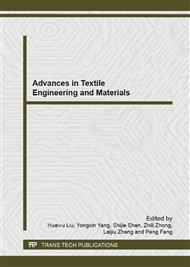p.53
p.57
p.62
p.67
p.76
p.80
p.85
p.90
p.96
Research on Properties of Fabrics Finished by Nano Titanium Dioxide
Abstract:
The article explored the finishing process of cotton fabric with nano titanium dioxide and adopted the dipping-rolling-drying process for the purpose of cotton fabric with good ultraviolet (UV) resistant performance. In this study, the concentration of titanium dioxide acted as variable factor to test and analysis the regular pattern of fabric UV resistant performance, mechanical properties and wearability after being treated with different concentrations of titanium dioxide solution. The results showed that the property of UV resistance improved with the increase of solution concentration. The ultraviolet protection factors (UPF) of fabric was 43.5 at a concentration of 0.5%, which was beyond the UV resistant standard of 40. However, the mechanical properties and wearability decreased in varying degrees with the increase in concentration of titanium dioxide. Thus the overall performance should be considered comprehensively to select the finishing process. All of these conclusions provide basic data for some in-depth research in the future.
Info:
Periodical:
Pages:
76-79
Citation:
Online since:
December 2012
Authors:
Keywords:
Price:
Сopyright:
© 2013 Trans Tech Publications Ltd. All Rights Reserved
Share:
Citation:


